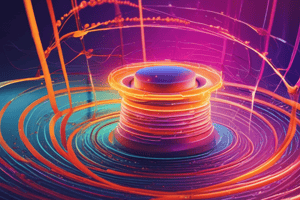Podcast
Questions and Answers
At the higher frequencies, what will happen to the capacitive reactance (XC) compared to the inductive reactance (XL) in the circuit?
At the higher frequencies, what will happen to the capacitive reactance (XC) compared to the inductive reactance (XL) in the circuit?
- XC will be lower than XL (correct)
- XC will be zero
- XC will be equal to XL
- XC will be higher than XL
What is the first step in determining the parameters for a parallel LCR circuit?
What is the first step in determining the parameters for a parallel LCR circuit?
- Calculate the phase angle of the circuit
- Calculate the current through each component
- Calculate the total circuit current
- Calculate the reactances XL and XC (correct)
How is the current through each component (IR, IC, and IL) calculated in a parallel LCR circuit?
How is the current through each component (IR, IC, and IL) calculated in a parallel LCR circuit?
- IR = V*R, IC = V/XC, IL = V/XL
- IR = V*R, IC = V*XC, IL = V*XL
- IR = V/R, IC = V*XC, IL = V*XL
- IR = V/R, IC = V/XC, IL = V/XL (correct)
How is the equivalent reactive current (difference between IC and IL) calculated in a parallel LCR circuit?
How is the equivalent reactive current (difference between IC and IL) calculated in a parallel LCR circuit?
What is the formula used to calculate the total circuit current (IT) in a parallel LCR circuit?
What is the formula used to calculate the total circuit current (IT) in a parallel LCR circuit?
How is the phase angle () of a parallel LCR circuit calculated?
How is the phase angle () of a parallel LCR circuit calculated?
Which of the following is NOT a step in the summary of parallel LCR circuit analysis provided in the text?
Which of the following is NOT a step in the summary of parallel LCR circuit analysis provided in the text?
What does the text state about the relationship between the capacitance of a capacitor and the capacitive reactance (XC)?
What does the text state about the relationship between the capacitance of a capacitor and the capacitive reactance (XC)?
What happens to the current through a capacitor when the capacitance value increases?
What happens to the current through a capacitor when the capacitance value increases?
What does the text say about the relationship between the voltage across a capacitor (VC) and the current through a capacitor (IC) when calculating capacitive reactance (XC)?
What does the text say about the relationship between the voltage across a capacitor (VC) and the current through a capacitor (IC) when calculating capacitive reactance (XC)?
What does the text state about the relationship between the frequency of the applied voltage and the current through a capacitive circuit?
What does the text state about the relationship between the frequency of the applied voltage and the current through a capacitive circuit?
What happens to the capacitive reactance (XC) when the capacitance value of a capacitor is increased?
What happens to the capacitive reactance (XC) when the capacitance value of a capacitor is increased?
What does the text state about the relationship between the amplitude of the applied signal and the inductive reactance (XL) in an AC circuit?
What does the text state about the relationship between the amplitude of the applied signal and the inductive reactance (XL) in an AC circuit?
What is the main difference between the effects of inductance and the effects of capacitance in an AC circuit, as mentioned in the text?
What is the main difference between the effects of inductance and the effects of capacitance in an AC circuit, as mentioned in the text?
What is the formula used in the text to calculate capacitive reactance (XC)?
What is the formula used in the text to calculate capacitive reactance (XC)?
Which of the following statements about the relationship between frequency and capacitive reactance (XC) is correct, according to the text?
Which of the following statements about the relationship between frequency and capacitive reactance (XC) is correct, according to the text?
What does the text say about the relationship between the inductive reactance (XL) and the amplitude of the applied signal in an AC circuit?
What does the text say about the relationship between the inductive reactance (XL) and the amplitude of the applied signal in an AC circuit?
Study Notes
Inductance and Inductive Circuits
- One henry is equal to the inductance required to induce one volt in an inductor by a change of current of one ampere per second.
- Inductance opposes any change in the magnitude of current in a circuit.
- Devices that provide inductance are called inductors, chokes, reactors, or coils.
- Inductors "choke off" and restrict sudden changes in current.
- Inductors react against changes in current, either increases or decreases.
Phase Angle and AC Circuits
- A cycle is one complete sequence of voltage or current change from zero to a positive peak, back to zero, through a negative peak, and back to zero again.
- For capacitive loads, current (I) comes before voltage (V), meaning current leads voltage.
- For inductive loads, current (I) comes after voltage (V), meaning current lags voltage.
- The phasor representing current (I) is drawn 90° clockwise from the phasor representing voltage (V).
Reactance and Impedance
- Inductive reactance (XL) is directly proportional to inductance (L) and frequency (f).
- The formula for XL is: XL = 2πfL
- XC is proportional to 1/C, meaning that as capacitance increases, XC decreases.
- XC is also proportional to 1/f, meaning that as frequency increases, XC decreases.
LCR Circuits
- To analyze a parallel LCR circuit, calculate the reactances (XL and XC), then calculate the current through each component (IR, IC, and IL).
- Calculate the equivalent reactive current (difference between IC and IL) and the total circuit current (IT).
- Calculate the total current phase angle using tan(θ) = (IL - IC) / IR.
Power and Energy Loss
- True power is the power dissipated in a circuit.
- Apparent power is the product of the voltage and current in a circuit.
- Energy losses occur due to resistance in a circuit.
Fleming's Left-Hand Rule and Induced EMF
- Fleming's left-hand rule states that if you point the thumb of your left hand in the direction of relative motion of the conductor and your index finger in the direction of the magnetic field, your middle finger, when extended, indicates the direction of the induced current.
- The induced voltage then moves in the same direction as the battery voltage.
- The self-induced voltage opposes both changes in current.
Studying That Suits You
Use AI to generate personalized quizzes and flashcards to suit your learning preferences.
Related Documents
Description
Learn about the concept of inductance by exploring its analogy with inertia. Discover the relationship between inductance, voltage, current change, and work required to start and stop a moving load.




